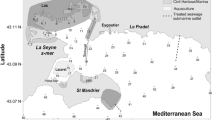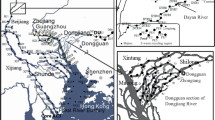Abstract
This study aims to detect PCB (polychlorinated biphenyls) and their distribution in river sediments of the river Lippe near a discharge point of mine drainage water raised from the coalmine Haus Aden. Recommendations from former literature studies, European and German-Industry-Standards (DIN) standards were followed to conduct a reproducible field study. The sampling, processing, and analysis of the sediment and core samples were delineated in detail explored in order to open up a new discussion about the methodical execution of environmental examinations of PCB. The results show that the normally executed standardization processes to interpret PCB concentrations do not work as assumed. This refers especially to the normalization of the content of organic carbon in the sediment. The heterogeneity of observed concentrations dominates and the concentration fluctuates enormously instead of following an often-described correlation between PCB and organic carbon or the percentage of fine grain. Congener profiles, which show the amounts of the six indicator congeners, do not show an obvious trend or indicate one corresponding contamination source. The findings invoke a new debate and examinations concerning deposition and adsorption processes of PCB in sediments, especially against the background of flooding the derelict mines of the Ruhr district in the coming decades.
Access this chapter
Tax calculation will be finalised at checkout
Purchases are for personal use only
Similar content being viewed by others
References
Borja J, Taleon DM, Auresenia J, Gallardo S (2005) Polychlorinated biphenyls and their biodegradation. Process Biochem 40(6):1999–2013
Brusske A, Eckartz-Nolden G, Fichthorn U, Grund I, Kalinka G, Müller W, Piegsa W, Reinders D, Schäfer K, Rosenbaum-Mertens J (2007) Gefährliche Stoffe _ Bericht zur Umsetzung der Gewässerschutzrichtlinie 76/464/EWG in NRW. Landesamt für Natur, Umwelt und Verbraucherschutz Nordhrein-Westfalen
Busch D, Furtmann K, Schneiderwind A, Zyuzina I, Reupert R, Sielex K (2007) Einfuss von Probenahme und Probenvorbereitung auf die Ergebnisse bei der Bestimmung ausgewählter prioritärer Stoffe nach der Wasserrahmenrichtlinie. In: Texte. Vol 32/07. Umweltbundeamt
Demirtepe H, Kjellerup B, Sowers KR, Imamoglu I (2015) Evaluation of PCB dechlorination pathways in anaerobic sediment microcosms using an anaerobic dechlorination model. J Hazard Mater 296:12–127
DIN 18123, April 2011. Soil, Investigation and Testing—Determination of Grain-size Distribution
DIN 18128, December 2002. Soil—Investigation and testing—Determination of ignition loss
DIN EN 15308, December 2016. Characterization of waste—Determination of selected polychlorinated biphenyls (PCB) in solid waste by gas chromatography with electron capture or mass spectrometric detection. DIN eV (ed)
Döring U, Marschner B (1998) Die Mobilisierbarkeit von ausgewählten organischen Schadstoffen in Rieselfeldböden. Bodenökologie und Bodengenese 26:42–51
Engel W, Kihl H (1987) Schwerentflammbare und gesundheitsunschädliche Hydraulikflüssigkeiten des Typs HFD für den Bergbau. Glückauf 123.2(22):1423–1426
Erickson MD, Kaley RG II (2011) Applications of polychlorinated biphenyls. Environ Sci Pollut Res 18(2):135–151
Goswami S (2017) Chennai’s soil. Dehli’s air most contaminated due to high PCB concentration: study. In: Down to Earth. https://www.downtoearth.org.in/news/environment/chennai-s-soil-and-delhi-s-air-most-contaminated-due-to-pcb-concentration-study-57217. Access July 2020
Hegnal A (2010) PCB, PCP, Dioxine und Furane. In: Dieckmann J, Hydvogel P, Stüdemann K, Wunderlich M (eds) Praxishandbuch Schadstoffe, pp 67–81
Hölting B, Coldewey WG (2005) Hydrogeologie. Spektrum Akademischer Verlag
IARC (2016) Polychlorinated Biphenyls and Polybrominated Biphenyls, vol 107. IARC Monogaphs
Lehnik-Habrink P, Hein S, Philipp R, Win T, Nehls I (2006) Erarbeitung und Validierung von Verfahren zur Bestimmung von polychlorierten Biphenylen und polychlorierten Terphenylen in organischen Materialien. Bundesanstalt für Materialforschung und -prüfung (BAM), ISBN 3-86509-481-3
Liang Y, Martinez A, Hornbuckle KC, Mattes TE (2014) Potential for polychlorinated biphenyl biodegradation in sediments from Indiana Harbor and Ship Canal. Int Biodeterior Biodegradation 89:50–57
Prinz H, Strauÿ R (2006) Abriss der Ingenieurgeologie, 4th edn. Spektrum Akademischer Verlag
Rahm H, Schweden U, Selent K, Düwel U (2015) Belastungen von Oberflächengewässern und von aktiven Grubenwassereinleitungen mit bergbaubürtigen PCB (und PCB-Ersatzstoffen)—Ergebnisse des·LANUV-Sondermessprogramms 2015. Landesamt für Natur, Umwelt und Verbraucherschutz Nordrhein-Westfalen
Rommel R, Rommel J, Schneider J, Schneider V (1998) Literaturstudie zum Transfer von organischen Schadstoffen im System Boden/Pflanze und Boden/Sickerwasser. Landesanstalt für Umweltschutz Baden-Württemberg
Schwarzbauer J (2017) Detailbericht 6: Risikoanalyse PCB und weitere organische Stoffe. In: Gutachten zur Prüfung möglicher Umweltauswirkungen des Einsatzes von Abfall- und Reststoffen zur Bruch-Hohlraumverfüllung in Steinkohlenbergwerken in Nordrhein-Westfalen, Teil 1. Ministerium für Klimaschutz, Umwelt, Landwirtschaft, Natur- und Verbraucherschutz des Landes Nordrhein-Westfalen; Ministerium für Wirtschaft, Energie, Industrie, Mittelstand und Handwerk des Landes Nordrhein-Westfalen
Tehrani R, Van Aken B (2014) Hydroxylated polychlorinated biphenyls in the environment: sources, fate, and toxicities. Environ Sci Pollut Res 21(10):6334–6345
Umweltbundesamt (2018) Dioxine und dioxinähnliche PCB in Umwelt und Nahrungsketten. Bundesumweltamt, ISSN 2363-829X
Author information
Authors and Affiliations
Corresponding author
Editor information
Editors and Affiliations
Rights and permissions
Copyright information
© 2022 The Author(s), under exclusive license to Springer Nature Singapore Pte Ltd.
About this chapter
Cite this chapter
Ohlemacher, S., Post, C., Baier, K. (2022). Mining Related PCB in Wetland Sediments of the River Lippe (North Rhine-Westphalia, Germany). In: Kumar, P., Nigam, G.K., Sinha, M.K., Singh, A. (eds) Water Resources Management and Sustainability. Advances in Geographical and Environmental Sciences. Springer, Singapore. https://doi.org/10.1007/978-981-16-6573-8_2
Download citation
DOI: https://doi.org/10.1007/978-981-16-6573-8_2
Published:
Publisher Name: Springer, Singapore
Print ISBN: 978-981-16-6572-1
Online ISBN: 978-981-16-6573-8
eBook Packages: Earth and Environmental ScienceEarth and Environmental Science (R0)




